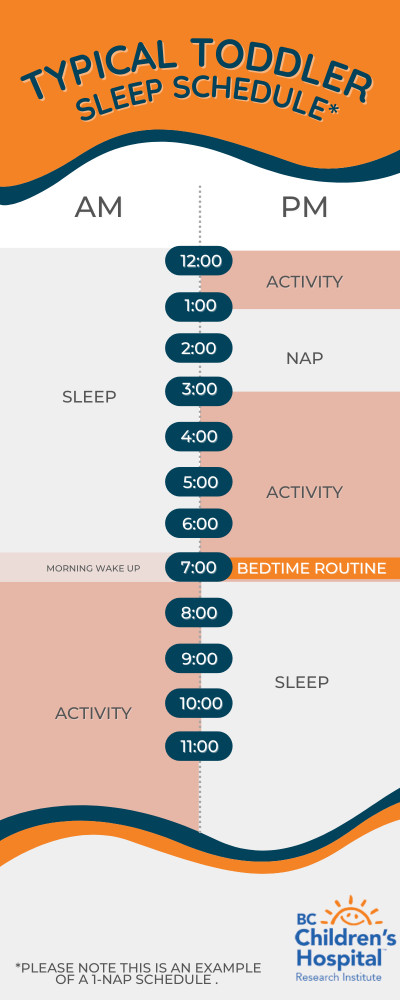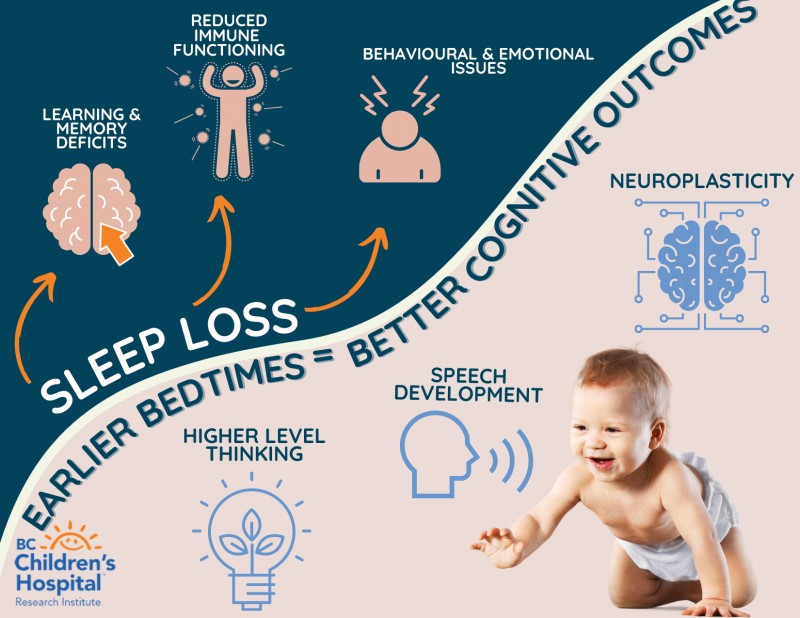Toddlers (18 months – 3 years)
Toddlers are growing so much physically, emotionally, and psychologically, and their attitudes towards sleep are often changing. How can I help my child fall asleep and stay asleep?
Sleep Architecture
At this age, the REM and NREM sleep cycle associated with adult sleep has been present for usually around a year, but it is still spread out over the course of the day, and sleep cycles are usually shorter than in adults. Over the course of year 2 and 3, the REM and NREM cycle is slowly being shifted towards consolidation at night. Cycles are also increasing in duration, representing a transition towards more adult-like sleep.
At this stage of development, many toddlers develop parasomnias, which are abnormal behaviors, emotions, or perceptions during sleep. These can include sleep walking, sleep terrors, or confusional arousals.
Click on the graphic below to view the enlarged image.
Sleep Environment
Toddlers benefit tremendously from a bedtime routine. Providing a sleeping environment that is conducive to a pre-established bedtime routine is extremely important. As a part of this bedtime routine, it is important to establish bedtime routines that promote proper sleep hygiene and prepare your toddler to go to sleep. Keeping a stable schedule, having a quiet and comfortable bedroom, and reducing electronic media and blue light exposure prior to bed are all examples of good sleep hygiene. It is also important to put your toddler to bed at the same time every night, as later bedtimes are correlated with lower quality of sleep and poorer cognitive outcomes.
Click on the graphic below to view the enlarged image.
Sleep Behaviour
At this age, the toddler will have consolidated their sleep at night to one bout of roughly 10-12 hours. It is still common at this age to have one or two daytime naps which last roughly one to two hours. The recommended total time slept during a 24-hour period at this age is roughly 13 hours.
It is important at this age to pay close attention to the way your child sleeps, as it is the common age of onset for sleep disorders or parasomnias. These include but are not limited to hypnic starts, benign neonatal sleep myoclonus, isolated sleep paralysis (ISP), rhythmic movement disorder, confusional arousals, sleep terrors, and sleep walking. If your child is displaying unusual behaviours during sleep such as insomnia, sudden movements, nightmares, or breathing issues, consult the resources below regarding parasomnias.
The most pronounced behavioural issue with toddlers is bedtime resistance. Methods such as extinction can be effective at reducing bedtime resistance, but there are many alternative methods of reducing bedtime resistance. As mentioned previously, toddlers benefit immensely from having a consistent bedtime routine. Having a routine which teaches proper sleep hygiene has been found to reduce bedtime resistance as well as night awakenings. This can take the form of a bedtime story which emphasizes proper aspects of sleep hygiene. It is common for parents to report bedtime resistance for toddlers at this age and developing strategies to help your toddler get to sleep are important for improving quality of sleep for both the toddler and parent.
Click on the graphic below to view the enlarged image.
Role of Sleep in Development
Sleep at this age, especially bedtimes, have been related to cognitive outcomes. Generally, later bedtimes are correlated with poorer cognitive outcomes. Sleep is generally involved in the reorganization of the brain or neuroplasticity, and there is evidence to suggest that the disruption of this process during sleep has a negative effect on cognitive abilities such as memory, attention, information processing, and speech. Additionally, there is evidence to suggest that sleep loss has an effect on executive functioning, or how well be process higher level information. Sleep loss in children has also been connected to obesity, reduced immune functioning, and behavioural and emotional issues.
As toddlers quickly develop more advanced behaviours such as speech and higher-level thinking, sleep has been shown to play an important role in facilitating this cognitive development.
Click on the graphic below to view the enlarged image.
Resources
If you think your toddler is having issues falling asleep or staying asleep, please consult the resources below.
Better Nights Better Days is a sleep therapy program designed for kids between the ages of 1-10 and focuses on remedies for sleep issues and general insomnia. If your toddler is having issues falling asleep and staying asleep, click on the button below to visit their website.
There’s a Monster in My Closet is a website that offers sleep education programs for kids over the first five years of life. For more information on better approaches to sleep and proper sleep hygiene, click on the button below visit their website.



